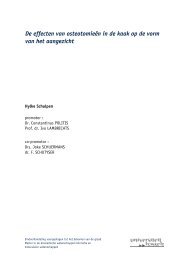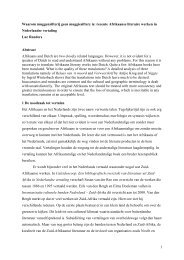Planning Problems in Intermodal Freight Transport ...
Planning Problems in Intermodal Freight Transport ...
Planning Problems in Intermodal Freight Transport ...
Create successful ePaper yourself
Turn your PDF publications into a flip-book with our unique Google optimized e-Paper software.
The distribution of conta<strong>in</strong>ers by truck may be considered as a pickup and delivery<br />
problem (PDP), which is a special case of the vehicle rout<strong>in</strong>g problem. Full conta<strong>in</strong>ers need to<br />
be picked up at their orig<strong>in</strong> and brought to the term<strong>in</strong>al or delivered from an <strong>in</strong>termodal<br />
term<strong>in</strong>al to their dest<strong>in</strong>ation. In a recent study Imai et al. [51] propose a heuristic procedure<br />
based upon a Lagrangian relaxation <strong>in</strong> order to schedule pickups and deliveries of full<br />
conta<strong>in</strong>er load to and from a s<strong>in</strong>gle <strong>in</strong>termodal term<strong>in</strong>al. Wang and Regan [52] propose a<br />
hybrid approach to solve a PDP conta<strong>in</strong><strong>in</strong>g one or more <strong>in</strong>termodal facilities. The authors<br />
apply time w<strong>in</strong>dow discretization <strong>in</strong> comb<strong>in</strong>ation with a branch and bound method.<br />
Justice [53] addresses the issue of chassis logistics <strong>in</strong> <strong>in</strong>termodal freight transport. A<br />
drayage company has to provide sufficient chassis at term<strong>in</strong>als <strong>in</strong> order to meet demand. A<br />
plann<strong>in</strong>g model is developed to determ<strong>in</strong>e when, where, how many and by what means<br />
chassis are redistributed. The problem is mathematically formulated as a bi-directional time<br />
based network transportation problem. Own software has been developed to calculate<br />
solutions us<strong>in</strong>g five sub-problems: f<strong>in</strong>d plann<strong>in</strong>g horizon, determ<strong>in</strong>e tra<strong>in</strong> arrivals and<br />
departures, obta<strong>in</strong> chassis supply and demand, obta<strong>in</strong> unit costs with each supply-demand<br />
pair, optimise for m<strong>in</strong>imum cost solution through simplex based iterations. It is assumed that<br />
supply and demand of chassis at a term<strong>in</strong>al <strong>in</strong> a given time period are known.<br />
5.2 Term<strong>in</strong>al Operator<br />
A tactical plann<strong>in</strong>g problem of term<strong>in</strong>al operators is the schedul<strong>in</strong>g of jobs <strong>in</strong> a<br />
term<strong>in</strong>al. Corry and Kozan [54] develop a load plann<strong>in</strong>g model to dynamically assign<br />
conta<strong>in</strong>ers to slots on a tra<strong>in</strong> at an <strong>in</strong>termodal term<strong>in</strong>al. The objectives are to m<strong>in</strong>imize excess<br />
handl<strong>in</strong>g time and optimize the mass distribution of the tra<strong>in</strong>. Because truck arrival times are









